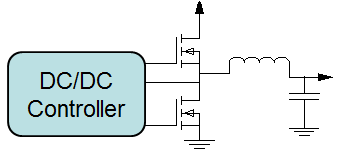I’m the type of person who can’t imagine reading books on an e-reader. New technologies just can’t replace the feeling of flipping pages and physically putting in a bookmark. Even though I know that e-readers can hold thousands of books, that they’re very portable and that I could buy cheaper digital versions of books, I don’t know that I will ever make the switch.
This feeling may be familiar to experienced power designers who have been using controllers with external field-effect transistors (FETs) for years, or really to any power engineer who has typically used only a DC/DC controller or DC/DC converter. It’s easy to get stuck in our ways, but stepping back and making sure that you know the big picture is good to do from time to time. In this post, I will delve into the considerations when choosing between designing with DC/DC step-down converters with integrated FETs (Figure 1) vs. DC/DC step-down controllers with external FETs (Figure 2).
Image may be NSFW.
Clik here to view.
Figure 1: DC/DC converter simplified diagram
Image may be NSFW.
Clik here to view.
Figure 2: DC/DC controller simplified diagram
Designing with a controller
Designing with controllers offers many benefits, including flexibility, thermal spacing, higher output currents and voltages, and lower cost.
Controllers with external FETs also have a few technical advantages over converters. Since the FETs are not integrated into the same package, controllers have better thermal spacing – a key trait for particularly heat-constrained designs. Controllers can also typically supply higher output voltages and currents than converters, enabling higher-power applications that converters might struggle with.
Since you will have flexibility in your FET selection, electing to go with controllers in many cases will help save on bill-of-materials (BOM) cost. Controllers are typically a more cost-effective option than converters, and when you combine that cost savings with the savings from lower-cost external FETs, the savings really add up. Cost is a key factor for just about everyone, so being able to save money on your power design is a huge plus.
Designing with a converter
Designing with a converter also offers many benefits, such as ease of use, smaller size and fewer components.
Choosing to use a converter may be an easier solution if you don’t want to spend a lot of time on the external circuitry part of the design (such as power FETs). Converters offer a more plug-and-play type experience, which is perfect if you have limited time or resources.
Improvements in integrated FET technology over the past several years have shrunk converter sizes. Designing with a converter will save you more board space compared to a controller. If your design is extremely space-constrained, a converter may be your best friend.
Integrated FETs simplify the design process by reducing the amount of external components and making layout easier. An easier layout will help accelerate time to market. There are also many applications where a board may contain hundreds, if not thousands, of components. Having an integrated solution option that will lower the component count could be reason enough to select a converter.
Conclusion
You can use converters or controllers in a wide range of applications, from enterprise servers and communication base stations to automotive and industrial applications. Now that you’ve read this refresher on the trade-offs, you should be better equipped to make the best selection for your design. No matter which route you decide to go, both TI’s DC/DC step-down converters with integrated FETs and TI’s DC/DC step-down controllers with external FETs make excellent options for point-of-load applications.
Additional resource
- Read more about TI’s step-down controllers, converters and MOSFETs.
- Watch the video “Point-of-Load Power Supplies- Converters or Controllers?” to learn more about choosing between converters and controllers.
Image may be NSFW.
Clik here to view.
